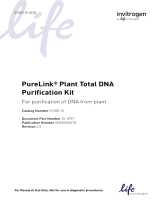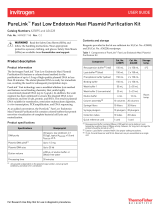Page is loading ...

PureLink™ Microbiome DNA Purification Kit
Purification of high-quality microbial and host DNA from buccal, vaginal, or skin swab samples
Catalog Number A29790
Pub. No. MAN0014268 Rev. A.0
WARNING! Read the Safety Data Sheets (SDSs) and
follow the handling instructions. Wear appropriate
protective eyewear, clothing, and gloves. Safety Data Sheets
(SDSs) are available from .
Product description
The Invitrogen™ PureLink™ Microbiome DNA Kit
enables fast of high-quality microbial and host DNA
from a wide variety of sample types. The kit uses proven
PureLink™ spin-column technology for robust yields of
DNA that is ready for downstream PCR, sequencing, or other
applications.
Typical DNA recovery is 0.1–5 µg from swab samples.
Procedure overview
This guide describes of DNA from buccal, vaginal, or
skin swab samples. (For of DNA from rectal or
environmental swab samples, refer to Pub. no. MAN0014333.) In
this procedure, the microorganisms are lysed by a
combination of heat, chemical, and mechanical disruption with
specialized beads. The sample is then applied to a PureLink™ spin
column, and the DNA that is bound to the column undergoes a
single wash step before elution.
Kit contents
Table 1 PureLink™ Microbiome DNA Purification Kit (Cat. no. A29790,
50 reactions)
Component Quantity Storage
S1—Lysis Buffer 40 mL
15°C to 30°C
S2—Lysis Enhancer 5 mL
S3—Cleanup Buffer[1] 12.5 mL
S4—Binding Buffer 45 mL
S5—Wash Buffer Concentrate[2] 13 mL
S6—Elution Buffer 5 mL
PureLink™ Spin Columns with
Collection Tubes
50
Component Quantity Storage
PureLink™ Collection Tubes 100
Bead Tubes[3] 50
[1] Not used in this procedure.
[2] Add 13 mL of 96–100% ethanol before use. See “Before you begin” on
page 2.
[3] Ships separately.
Required materials
Unless otherwise indicated, all materials are available through
. MLS: Fisher
( ) or other major laboratory supplier.
Table 2 Required materials not included with the kit
Item Source
Heat block, dry bath, or water bath, 65°C MLS
(
Optional
) For dry bath, Lab Armor™ Beads Cat. no. A12543
Microcentrifuge capable of 14,000 ×
g
MLS
Vortex mixers, 2[1] MLS
For vortex bead homogenization: hands-free
adapter for vortex mixer, with horizontal tube
orientation
Fisher Scientific
NC0070788[2]
(
Optional
; alternative to vortex bead
homogenization) Bead mill homogenizer
Omni 19-040, or
equivalent
Adjustable pipettors, 100–1000 µL MLS
Microcentrifuge tubes, DNase-free, 1.5 mL or
2.0 mL
MLS
4N6FLOQSwabs™, Regular Tip, or equivalent Cat. no. 4473979, or
equivalent
Ethanol, 96–100% MLS
[1] For vortex bead homogenization: we recommend using two mixers, one
dedicated to the hands-free adapter.
[2]Cat. no. AM10024 (not available for sale) can also be used.
USER GUIDE
For Research Use Only. Not for use in diagnostic procedures.
15°C to 30°C

Workflow
Prepare the
lysate 30 min
Heat
Bead beat
Supernatant
Sample
+ S1 + beads + S2
Bind the DNA
to the column 5 min
Bind
Column
+ S4
Wash and
elute the DNA 5 min
Wash
Elute
Column
Flow-through
+ S5
+ S6
: centrifugation
Important procedural guidelines
Sample input requirements and handling
• The procedure was developed with 4N6FLOQSwabs™. Some
testing was performed with Puritan™ PurFlock™ Ultra Flocked
Swabs (Fisher Scientic Cat. no. 22-025-192).
• Collect swab samples according to your laboratory guidelines
and experimental needs.
• Ensure that the swabs are broken to 1–3 cm in length, so that
they t inside the Bead Tube with the screw cap completely
tightened.
Alternatives to the optimized procedure
• This procedure is optimized for homogenization by bead
beating on the vortex mixer with horizontal agitation. This is
a cost-eective method for recovery of high-quality microbial
DNA. Ensure that the vortex adapter enables horizontal
agitation; adapters with a vertical tube orientation may not
agitate adequately.
Note: Balance the vortex adapter to ensure proper movement
of the adapter and optimal homogenization.
If you use a bead mill homogenizer, follow the
manufacturer's instructions to optimize sample disruption.
• This procedure is optimized for centrifugations at 14,000 × g.
The PureLink™ Spin Columns with Collection Tubes can
withstand up to 16,000 × g.
If your microcentrifuge is not capable of 14,000 × g, adjust the
centrifugation times to ensure that all of the sample passes
through the column.
Options for elution
• The DNA can be eluted from the column with 50–200 µL of
S6—Elution Buer, to optimize the concentration of the
recovered DNA.
• Two sequential elution steps with S6—Elution Buer might
increase the yield slightly. For example, for a total elution
volume of 100 µL, either:
– Perform two sequential elution steps with 50 µL of S6—
Elution Buer, or
– Perform the rst elution step with 100 µL of S6—Elution
Buer, then apply the ow-through (containing the
eluted DNA) to the same column and repeat for a
second elution.
• If desired, perform the nal elution spin into nuclease-free
1.5-mL microcentrifuge tubes, instead of the collection tubes
supplied with the kit, which do not have caps. Position the
cap of the microcentrifuge tubes opposite the direction of
rotation.
Before you begin
Before first use of the kit: prepare S5—Wash Buffer
Add 13 mL of 96–100% ethanol to S5—Wash Buer Concentrate ,
mix well, and store at room temperature.
Before each use of the kit
If precipitate is visible in S1—Lysis Buer or S4—Binding Buer,
warm the buers at 37°C for 5 minutes and shake well to dissolve
the precipitate.
2
PureLink™ Microbiome DNA Purification Kit User Guide (Buccal, Vaginal, or Skin Swab Samples)

Methods
Perform the procedure at room temperature (20–25°C), unless otherwise indicated.
a. Add 800 µL of S1—Lysis Buer to the Bead Tube, then add one swab.
b. Add 100 µL of S2—Lysis Enhancer, cap securely, and vortex briey.
c. Incubate at 65°C for 10 minutes.
d. Bead beat for 10 minutes at maximum speed on the vortex mixer.
Use the hands-free adapter and horizontal agitation.
e. Centrifuge at 14,000 × g for 1 minute.
f. Transfer up to 500 µL of the supernatant to a clean microcentrifuge tube, avoiding the bead pellet
and any debris.
Some contact with the swab or swab debris will not aect DNA quality.
1Prepare the lysate
a. Add 900 µL of S4—Binding Buer, and vortex briey.
b. Load 700 µL of the sample mixture onto a spin column-tube assembly, and centrifuge at
14,000 × g for 1 minute.
c. Discard the ow-through, and repeat step 2b with the remaining sample mixture.
2Bind the DNA to the
column
a. Place the spin column in a clean collection tube, add 500 µL of S5—Wash Buer, then centrifuge
the spin column-tube assembly at 14,000 × g for 1 minute.
b. Discard the ow-through, then centrifuge the spin column-tube assembly at 14,000 × g for
30 seconds.
The second centrifugation optimizes removal of S5—Wash Buer, which could interfere with
downstream applications.
c. Place the spin column in a clean tube, add 50 µL of S6—Elution Buer, then incubate at room
temperature for 1 minute.
d. Centrifuge the spin column-tube assembly at 14,000 × g for 1 minute, then discard the column.
The puried DNA is in the tube.
The DNA is ready for immediate use. Alternatively, store the puried DNA:
• At 4°C for up to 1 week.
• At –20°C for long-term storage.
3Wash and elute the DNA
PureLink™ Microbiome DNA Purification Kit User Guide (Buccal, Vaginal, or Skin Swab Samples)
3

Troubleshooting
Observation Possible cause Recommended action
Low yield Inefficient lysis. Heat samples at 95°C for 5–10 minutes instead of at 65°C for
10 minutes.
Heat at 95°C for 5–10 minutes, and bead beat for a longer time or
using a higher power setting.
Low levels of DNA in the sample. Repeat the purification with more starting material.
Inhibition of PCR or other
downstream reactions
Presence of inhibitors in the
recovered DNA.
Dilute the DNA 10- to 100-fold for PCR.
Repeat the purification with an additional cleanup step:
1. After bead beating and centrifugation, transfer up to 400 µL of
the supernatant to a clean microcentrifuge tube.
2. Add 250 µL of S3—Cleanup Buffer, and vortex immediately.
3. Centrifuge at 14,000 ×
g
for 2 minutes, then transfer up to
500 µL of the supernatant to a clean microcentrifuge tube,
avoiding the pellet.
4. Proceed to “Bind the DNA to the column” on page 3.
Documentation and support
Revision history MAN0014268 (English)
Revision Date Description
A.0 September 2015 New document.
Limited product warranty
Life Technologies Corporation and/or its aliate(s) warrant their
products as set forth in the Life Technologies' General Terms and
Conditions of Sale found on Life Technologies' website at
www.thermosher.com/us/en/home/global/terms-and-
conditions.html. If you have any questions, please contact Life
Technologies at www.thermosher.com/support.
The information in this guide is subject to change without notice.
DISCLAIMER
TO THE EXTENT ALLOWED BY LAW, LIFE TECHNOLOGIES AND/OR ITS AFFILIATE(S) WILL NOT BE LIABLE FOR SPECIAL, INCIDENTAL, INDIRECT, PUNITIVE, MULTIPLE, OR
CONSEQUENTIAL DAMAGES IN CONNECTION WITH OR ARISING FROM THIS DOCUMENT, INCLUDING YOUR USE OF IT.
Important Licensing Information: These products may be covered by one or more Limited Use Label Licenses. By use of these products, you accept the terms and conditions of all
applicable Limited Use Label Licenses.
©2015 Thermo Fisher Scientific Inc. All rights reserved. All trademarks are the property of Thermo Fisher Scientific and its subsidiaries unless otherwise specified.
thermofisher.com
10 September 2015
/












